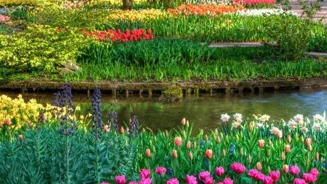Discover how to create a child-friendly garden that sparks creativity! From sensory experiences to wildlife elements, these 8 tips will transform your backyard into a paradise for little ones. Let's nurture
nature and imagination together
Gardening with your kids can be a wonderful experience. You get to spend quality time together, they learn about nature, and everyone enjoys the fresh air and sunshine. But let's be honest, a garden designed purely for adults might not exactly appeal to youngsters.
Think pristine flowerbeds they're not allowed to touch, or perfectly manicured lawns where running and playing is frowned upon. To truly spark a child's imagination and turn your green space into a haven of fun and learning, you need to think like a kid!
So, ditch the 'look but don't touch' policy, and get ready to transform your backyard into a child-friendly paradise. Here are eight tips to get you started on creating a garden that inspires creativity and keeps your little ones entertained for hours.
Create a safe, small 'kids' zone' with gardening tools for imaginative play
First, dedicate a special 'kids' zone'. This doesn't need to be massive, even a small corner of the garden will do. This is their dedicated space to dig, plant, build, and generally get messy! Make sure this area is safe - check for any sharp objects or poisonous plants.
Provide them with their own set of gardening tools – small trowels, watering cans, and maybe even a little wheelbarrow. Seeing tools specially sized for them makes children feel important and involved, and encourages them to take ownership of their garden space..
Building material like untreated wooden planks and logs will provide hours of creative fun.
Engage all senses in garden design for powerful learning
Next, think about sensory experiences. Gardens aren't just about what you see. Engage all their senses! Plant fragrant herbs like mint and lavender that they can touch and smell. Include plants with interesting textures, like lamb's ear with its soft, velvety leaves, or spiky ornamental grasses.
Add elements that create sound, like wind chimes or a small water feature. Visuals are important with brightly colored flowers like marigolds, zinnias and sunflowers. You can even create a mud kitchen using old pots, pans, and utensils, allowing your children to create and explore. Sensory experiences can be a powerful tool for learning
Add fun elements to your yard for kids to enjoy outdoor activities
Add things that are fun. There are a million reasons to bring fun into your yard. These will have children spending hours in the area. One option is adding a small climbing frame. It can be crafted from wood and repurposed materials. Also consider using a small slide with soft landing.
Creating a small area with sandpit can be a unique option. Allow the kids to build sandcastles and create other designs using the sand. The sandpit can be covered when unused. Encourage your child's imagination and outdoor activity.
Plant easy-to-grow seeds like sunflowers, radishes, and cherry tomatoes to excite kids about gardening
Now we will consider planting things that are easy to grow will. Kids love instant gratification. So, choose seeds that germinate quickly and plants that are relatively low-maintenance. Sunflowers are a classic choice – they grow tall and strong, and kids love watching them develop.
Radishes are also a great option as they sprout quickly and can be harvested in just a few weeks. Cherry tomatoes are another favorite, as children can pick and pop them straight into their mouths (after washing them, of course!).
Let your kids choose what they want to grow – this will make them feel more invested in the garden and encourage them to take care of their plants. These will greatly help you on your way to making your kids more excited about gardening.
Encourage wildlife with bird feeders, birdbath, bee house for learning and appreciation
Also add elements to encourage wildlife. Bird feeders are an easy attraction. Install a bird bath in area easily viewed by children. Put up a small bee house to attract pollinators. Not only does this add interest to the garden, but it also provides valuable learning opportunities.
Kids can learn about different bird species, the importance of pollinators, and the interconnectedness of nature. It also encourages them to be more observant and appreciative of the natural world around them. These are simple additions that will create a mini sanctuary for smaller animals.
Children create fairy garden with pebbles, figurines, twigs, plants
Also consider creating a fairy garden. The children can add pebbles to make roadways. They can add small figurines to create a miniature environment. Use twigs and tiny plants to create little houses and landscapes. This activity could inspire countless hours of play and creativity.
It will also foster a love for gardening and imaginative play. It creates a whimsical and enchanting space that captures the imaginations of kids of all ages. It turns the garden into a magical world.










